Mongolia
- a land apart
http://www.greenkiwi.co.nz/footprints/frames/mn_right.htm
From the striking architecture that
typifies Ulaan Baatar, soviet concrete tower block, to the sweeping steppe and
the ever present ger, this journey is a wondrous experience.
Big in every way, Mongolia is one of the few places where humans are still in
awe of their place in the world. 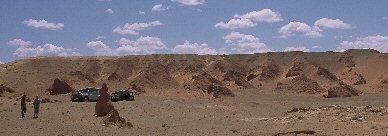
Our itinerary follows an arc south and west of Ulaan Baatar via Khara Khorn
(Karakorum) and then curves back east to a ger camp south of Ih Bogd Uul. From
here we visit the Flaming cliffs made famous by Roy Chapman Andrews adventure
/ scientific expeditions in the 1920s and 1930s.
Our visit will coincide with the Naadam festival in Ulaan Baatar. This is an
incredible Mongolian equivalent of the Olympics. The opening of which is well
worth visiting for the wrestling, archery and knuckle bones, a very particular
Mongolian passion.
In Mongolia as elsewhere, an abundance of patience goes a very
long way to improving your experience. Even the most carefully organised itinerary
may go awry. There can be long hours driving on appalling roads; the hotels
are not particularly luxurious and the climate is variable... all of these things
contribute to our adventurous Mongolian journey.
We
run this tour every two or three years according to demand.
We are going in July 2004. And with sufficient demand will go in 2005, at around
the same time.
Please make contact
if you are interested..
 Top of page
Top of page
The General Plan
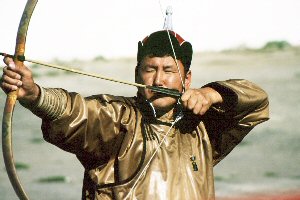
The day after arriving in Ulaan Baatar we leap straight into Mongolia's largest
festival - the Naadam. Horse racing is taken very seriously and is truly spectacular.
Several thousand people on horseback jam the finish line. All hoping to touch
the winning horse. To do so is considered a lucky omen. The horse races follow
wrestling in open fronted jackets. The jacket's fronts were removed to avoid
a woman ever becoming the national wrestling champion again. Archery and knuckle
bones make up the other "manly" sports of the Naadam. Whilst in Ulaan
Baatar we also have the opportunity to see Mongolia's best folk dancing groups
as well as hear throat singing, which is a personal highlight. This is of course
a passion that Mongolia shares with Tuva, just across the border to the north.
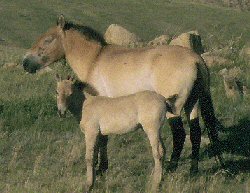 From
Ulaan Baatar we move west south west to visit the home the Przewalski (or Takhi)
horse. The only truly wild horse in the world and one of the world's most endangered.
We visit the national park where they have been reintroduced to Mongolia, and
get a close up look at them, boy are they cute. [more
detail on the National Park and Takhi horses]
From
Ulaan Baatar we move west south west to visit the home the Przewalski (or Takhi)
horse. The only truly wild horse in the world and one of the world's most endangered.
We visit the national park where they have been reintroduced to Mongolia, and
get a close up look at them, boy are they cute. [more
detail on the National Park and Takhi horses]
Further west we visit the Khogno Khan mountain range and it's abandoned monastery.
A wonderful opportunity to walk through stone outcrops not unlike those evoked
by Frank Herbert in his novel 'Dune'. Interesting history in a stunning setting,
and our only hedgehog siting in Mongolia so far. There's time here for horse
riding, rock scrambling or hiking in and around our Ger camp.
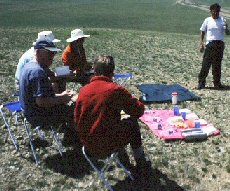 Karakorum
(Khara Khorin) is our next stop. In 1220 AD Genghis Khan based the capital of
the Mongolian empire here. Kublai Khan moved it to present day Beijing some
40 years later. Though it was only the capital for a short time Karakorum symbolises
mongolia's remote and exciting nature.
Karakorum
(Khara Khorin) is our next stop. In 1220 AD Genghis Khan based the capital of
the Mongolian empire here. Kublai Khan moved it to present day Beijing some
40 years later. Though it was only the capital for a short time Karakorum symbolises
mongolia's remote and exciting nature.
Mongolians make this journey special. Even in the poorest and most isolated
areas we've been greeted by wonderful hospitality and company. Along the way
I'll organise some 'Airag' (fermented mares milk) or Mongolian beer. An unusual
drink the locals love to share. It's amazing how everyone's foreign language
fluency improves.
 Further
south again we enter the Gobi desert proper. Home to camels, vistas that go
on forever, dinosaur bones, wildlife and petroglyphs. We visit the area around
the Ikh bogd uul range where we will see evidence of human habitation from the
middle Palaeolithic period [60,000 years ago: ref].
There are numerous sites where we see petroglyphs from the Bronze age [3,000
to 4,000 years old ref].
We could also stumble upon bronze age square standing stone graves (ref)
or tumuli from other periods.
Further
south again we enter the Gobi desert proper. Home to camels, vistas that go
on forever, dinosaur bones, wildlife and petroglyphs. We visit the area around
the Ikh bogd uul range where we will see evidence of human habitation from the
middle Palaeolithic period [60,000 years ago: ref].
There are numerous sites where we see petroglyphs from the Bronze age [3,000
to 4,000 years old ref].
We could also stumble upon bronze age square standing stone graves (ref)
or tumuli from other periods.
From Ikh bogd uul we head east to the singing sands of Khongoryn els a large
area of sand dunes and saxaul forest. The saxaul tree is a favourite food of
the endemic Bactrian camel. Khongoryn els is where we have an opportunity for
a ride on these imposing beasts. This area is also home to the Altay Argali
sheep, who are one of the largest and most elusive breeds in the world. Khongoryn
Ells means singing sands, an evening walk will give us the opportunity to match
the name with the reality.
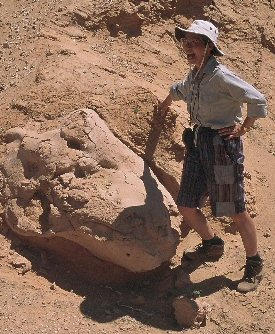 A
morning's travel away we arrive at the Flaming cliffs, made famous by Roy Chapman
Andrews of the American Museum of Natural History (ref).
It was here that Andrews' team discovered the first fossils confirming that
dinosaurs laid eggs. Today it is still visited by paleontological expeditions,
though fossil sites to the south west have proved more fertile.
A
morning's travel away we arrive at the Flaming cliffs, made famous by Roy Chapman
Andrews of the American Museum of Natural History (ref).
It was here that Andrews' team discovered the first fossils confirming that
dinosaurs laid eggs. Today it is still visited by paleontological expeditions,
though fossil sites to the south west have proved more fertile.
Further east again we reach the area around Yolyn Am.
This canyon in the southern Gobi is famous for it's year round "glacier"
but should really be lauded for it's spectacular wild life. On the walk down
the canyon we can expect to see picas, ibex and literally hundreds of other
species. We then have the option of returning up the canyon or going on a rather
steep excursion up the canyon wall to slum it with the ibex for a while. One
of my favourite spots.
Our last adventure in the Gobi is getting on the Mongolian Airlines
flight back to Ulaan Baatar.
In Ulaan Baatar we've got time to wash the Gobi from our bodies, to do that
last bit of shopping and enjoy our final meal together before heading home.

 Top of page
Top of page
A brief history of Mongolia
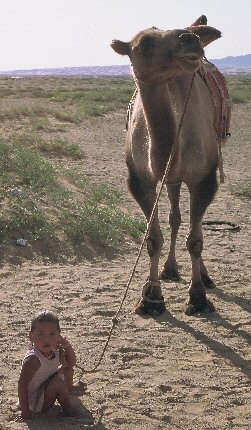 From
such little things big things grow.The largest empire in the history of the
world was created by a child who grew up much as nomad youngsters do today.
From
such little things big things grow.The largest empire in the history of the
world was created by a child who grew up much as nomad youngsters do today.
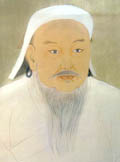 Chingis
Khaan was a warrior, philosopher and conqueror of the world. Born in 1167 AD
as Temujin he received the honorary name Chingis Khaan ('universal or oceanic-ruler')
in 1206 AD.
Chingis
Khaan was a warrior, philosopher and conqueror of the world. Born in 1167 AD
as Temujin he received the honorary name Chingis Khaan ('universal or oceanic-ruler')
in 1206 AD.
Declaring 'I am the punishment of God...' he created the largest
empire ever, and it was said of him that "and
death floated in the air behind his armies". From the arctic to Tibet,
and the sea of Japan to Hungary, he ruled supreme until his death in 1227 AD.
Mongolia is an amazing mix of east and west. The language is a member of the
Ural-Altaic family of languages, and the downward-script is the result of Kyrgyz'
influences around 840 AD.
It was this script with which Chingis Khaan wrote 'The Secret History of the
Mongols' establishing law and order for the tribes. His grandson Kublai Khan
(ca 1216 to 1294 AD) became the emperor of China's Yuan dynasty. A great ruler
and open minded thinker Khublai stabilised his empire, improved communications,
introduced paper money, and provided the back drop for Marco Polo's stories,
so unbelievable in Europe of the time.
The Ming dynasty (ca 1368 to 1644 AD) saw the end of Mongolian rule in China.
With the rise of this dynasty self determination ended in most of the area we
now know as Mongolia.
With the downfall of the Quing Dynasty in 1911 AD the Mongolian's created an
independent state. World events, particularly the Russian revolution saw Mongolia
coerced into becoming the second communist state in the world. Mongolia's new
ruler Choibalsan mimicked Stalin in many ways. His rule was also characterised
by purges, especially against monks, tens of thousands of whom were murdered.
With the collapse of the Soviet block, a major capital investor and buyer of
Mongolia's products, democracy rapidly came to the fore. The first democratic
elections were held in June 1990.

 Top of page
Top of page
What else?
What is a Ger?
A ger is the traditional form of dwelling in Mongolia. It consists of a wooden
frame covered with one or two layers of felt. The felt is covered with an outer
skin of canvas to provide protection from rain.
You will see gers in Ulaan Baatar and out on the steppe. No matter where the
ger is they're all arranged in much the same way. The entrance faces south,
the west side is for males and the east side for females. The most important
possessions and guests are placed in the North West part of the Ger. A central
stove provides warmth and heat for cooking. Items considered to be male like
saddles and airag (fermented mares milk beer) bottles are kept on the west side.
Items like the house-hold utensils are to the east.
Though small they are particularly well suited to Mongolian conditions. In the
hot months the ger's "skirts" can be lifted allowing breezes through
whilst still providing shade. In the winter the ger's "skirts" can
be dropped down and covered with snow, ensuring the ger is wind proof and warm.
Where do we stay?

In Ulaan Baatar we stay in medium grade hotel accommodation. In the countryside
we stay in ger camps.
A Ger camp is the Mongolian equivalent of a motel. Normal family sized gers
serve as individual rooms with two to four beds per ger. The accommodation gers
are accompanied by a dining room ger (about four times normal size) and an ablution
block, with shower and toilet facilities. This visually and ecologically elegant
solution to housing numbers of people makes the most of local crafts, talents
and materials.
What do we eat?
Mongolians have a reputation for only eating meat. Surprisingly Mongolia is
also vegetarian friendly, in part due to Russian influence. This influence translates
into clean and filling meals no matter where you eat in Mongolia, be it in the
capital or out in the country side. Staples like rice are imported from China
while grapes and watermelon make their way east from the central Asian republics.
The fact that these foods exist seems to elude the notice of some locals. On
my last trip one person greeted me "so you're the people who eat vegetables
eh ?".
What about shopping?
Mongolia isn't a shoppers paradise, malls haven't made their way here yet.
There is however the very best type of department store in Ulaan Baatar. A multi
story marvel it sells everything one might want, from vehicles and plumbing
supplies to knives and saddles. Local crafts tend to be utilitarian; leather,
felt, clothes, and horse related items. There is however a thriving business
in water color paintings of Mongolian scenes and of course Genghis Khan. One
of my most inveterate shopper friends came with me on our first foray to Mongolia.
She found more than enough to keep her occupied. Come prepared to sieze your
shopping opportunities when they appear.
How physically challenging
is this tour?
This journey is primarily focused on gaining an overview of Mongolia. Being
such a vast country this takes a bit of doing. In our case we travel in modern
Uaz jeeps. This means that everyone has a reasonable seat and a good view, rather
than being crammed into the back of a Uaz van with small windows. Uaz jeeps
are what the locals use, should we need spare parts, they're available. 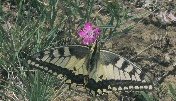
Daily walks, horse and camel rides provide some of the other physical challenges.
With these realities in mind, a reasonable level of fitness will improve your
experience greatly.
How many people will
go?
We specialise in small group travel. Because of the places that we go and our
preferred method of travel (jeep) this journey is for no more than eight clients.
Insurance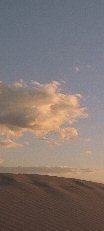
Although we don't anticipate any problems, there are sure to be some! Mongolia
is a world apart. Isolated for almost 70 years from the western world, it is
one of the poorest nations on earth, so don't expect sophisticated infrastructure.
As such Mongolia's medical facilities are limited, though improving year by
year.
You should make sure that your travel insurance covers medical evacuation to
a first world facility outside Mongolia. Please check that your travel insurance
policy covers helicopter evacuation from the site of the accident to an international
airport, and from that airport to your home or other major western medical center
(Hong Kong or Singapore in this case).
We recommend and use the Mike Henry insurance available through House of Travel.
Why go?
There are a thousand different reasons. Hereís one that appeals
Donít let the feeble excuse of work
keep you back; remember the Haitian proverb: If work is such a good thing,
how come the rich havenít grabbed it all for themselves ?
The Tropical Traveller, 1982, John Hatt (1948 - )

 Top of page
Top of page
Mongolia Itineraries
and prices 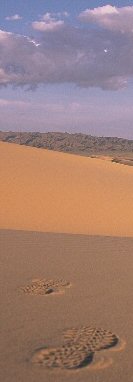
Mongolia,
Main group
| Mongolia Main Group |
| Main Group ex New Zealand |
| Approximate dates
08-26 July 2004
|
|
|
19 day trip |
|
5 nights in Ulan Baatar |
|
11 nights Ger Camps |
|
transportation + food as detailed |
|
2004 prices will be advised when available |
|
Price depends on exchange rate |
Please note: These prices are not final, we reserve the right to make changes
should major movements occur in currency or airfares.N.B. If you choose
the land-only option please organise your air travel early. Flights to and
from Asia are very heavily booked. I am happy to help with suggestions and
flight bookings if you wish.
What shall we tell you? Tales,
marvellous tales, Of ships and stars and isles where good men rest, Where
nevermore the rose of sunset pales, And winds and shadows fall toward the
west.
The Golden Journey to Samarkand, James Elroy Flecker
Mongolia,
Land only group 
Those who wish to travel elsewhere in Asia or travel on to Europe may prefer
this option.
| Mongolia |
| Land Only ex Ulaan Baatar |
| Approximate dates
08-26 July 2004
|
|
|
19 day trip |
|
4 nights in Ulan Baatar |
|
13 nights Ger Camps |
|
land transportation + food as detailed |
|
2004 prices will be advised when available |
|
Price depends on exchange rate |
Please note: These prices are not final, we reserve the right to make changes
should major movements occur in currency or airfares.
N.B. If you choose the
land-only option please organise your air travel early. Flights to and from
Asia are very heavily booked. I am happy to help with suggestions and flight
bookings if you wish.
Mongolia
What do you get...and, what you don't get?
For all groups 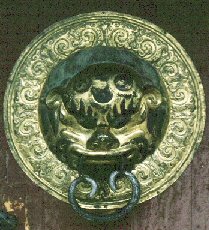
A personal introduction to some new places and interesting people! ·
Return economy airfare from Christchurch, Wellington or Auckland to Mongolia
· Twin-share accommodation in all cities · Breakfasts everyday
· lunch and dinner while outside Ulaan Baatar,· Airport transfers
and departure tax in Mongolia.·Ground transportation in Mongolia, translator
and guide.
Mongolia
What you don't get
NZ departure tax · dinner, unless mentioned · personal insurance
and medical expenses · excess baggage charges · items of a personal
nature and items not explicitly mentioned by Footprints.
 Top of page
Top of page
Is it worth it?
On this trip youíll take time to visit some a truly special place. Mongolia,
the experience of a lifetime.
.....if this one day in the lifetime
of a hundred years is lost,
will you ever get your hands on it again?
Eihei Dogen (1200-1253)
 Top of page
Top of page
If you would like more information about a specific
trip please email your wishes and
we shall respond.
If the timing of this trip does not suit, and you would like us to arrange a
tour for your own independent group check
out what we offer.
top of page site map contact us







 Chingis
Khaan was a warrior, philosopher and conqueror of the world. Born in 1167 AD
as Temujin he received the honorary name Chingis Khaan ('universal or oceanic-ruler')
in 1206 AD.
Chingis
Khaan was a warrior, philosopher and conqueror of the world. Born in 1167 AD
as Temujin he received the honorary name Chingis Khaan ('universal or oceanic-ruler')
in 1206 AD.






